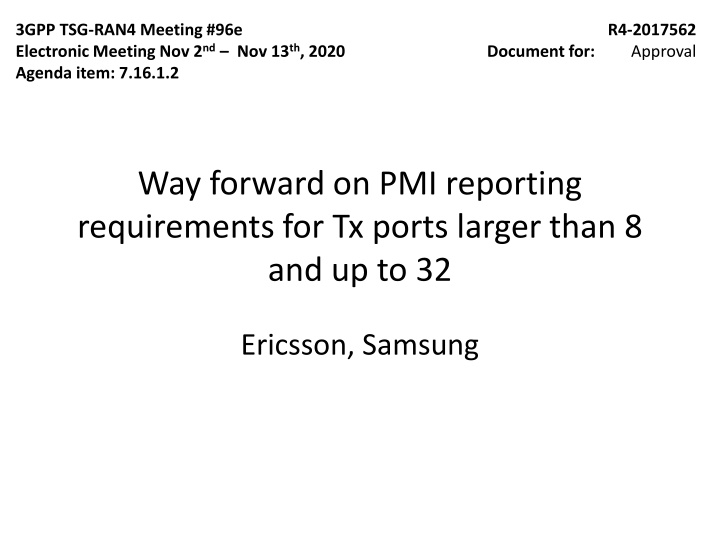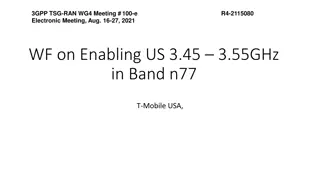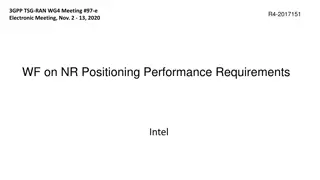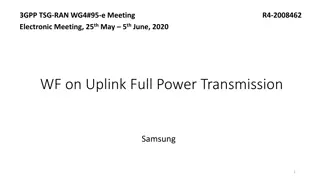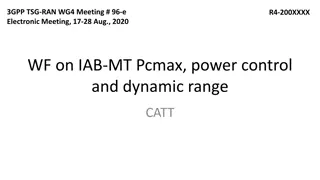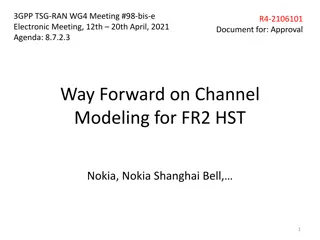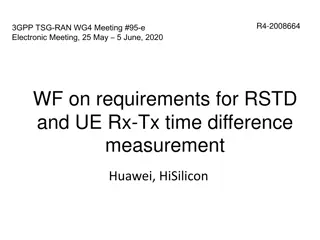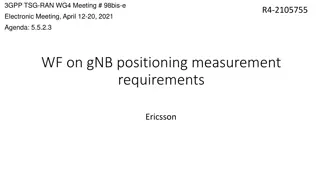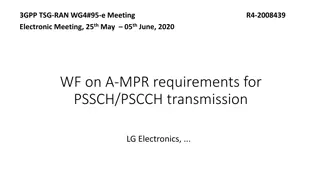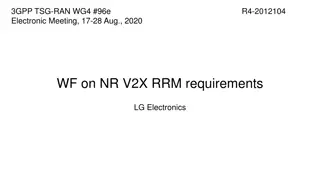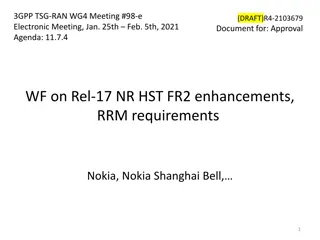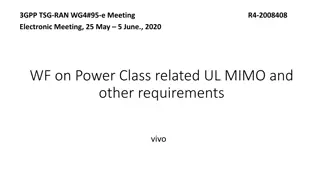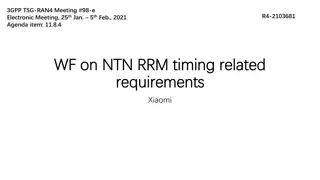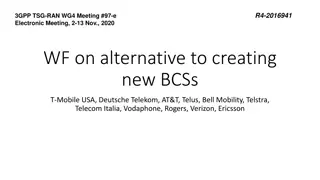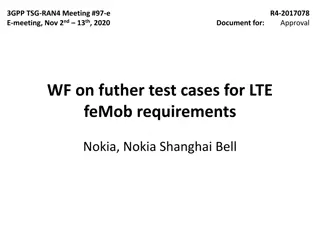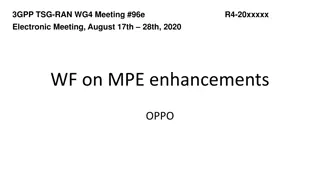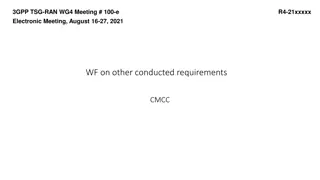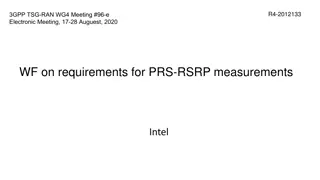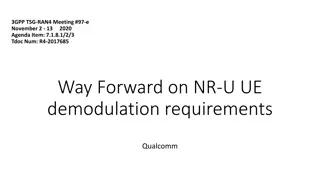3GPP TSG-RAN4 Meeting #96e - Way Forward on PMI Reporting Requirements
Approval document for addressing PMI reporting requirements for Tx ports larger than 8 and up to 32 by Ericsson and Samsung discussed during 3GPP TSG-RAN4 Meeting #96e. The timeline includes agreements from previous meetings (#92, #92bis, #93, #94e, #94e-Bis, #95e) along with simulation assumptions and detailed simulation assumptions. The meeting also covered the introduction of Rel-15 Type II test setup, SU-MIMO codebook requirements, and performance enhancements for MU-MIMO scenarios in Rel-17.
Uploaded on Oct 10, 2024 | 1 Views
Download Presentation

Please find below an Image/Link to download the presentation.
The content on the website is provided AS IS for your information and personal use only. It may not be sold, licensed, or shared on other websites without obtaining consent from the author.If you encounter any issues during the download, it is possible that the publisher has removed the file from their server.
You are allowed to download the files provided on this website for personal or commercial use, subject to the condition that they are used lawfully. All files are the property of their respective owners.
The content on the website is provided AS IS for your information and personal use only. It may not be sold, licensed, or shared on other websites without obtaining consent from the author.
E N D
Presentation Transcript
3GPP TSG-RAN4 Meeting #96e Electronic Meeting Nov 2nd Nov 13th, 2020 Agenda item: 7.16.1.2 R4-2017562 Approval Document for: Way forward on PMI reporting requirements for Tx ports larger than 8 and up to 32 Ericsson, Samsung
Timeline of previous agreements #92 #92bis #93 #94e #94e-Bis #95e #96e WF: R4-1910017 WF: R4-1912834 simulation assumptions: R4-1912811 WF: R4-1915858 Simulation assumptions: R4-1915859 WF: R4-2002393 Simulation assumptions: R4-2002394 WF: R4-2005549 Simulation assumptions: R4-2005550 WF: R4-2008846 Simulation assumptions: R4-2008847 WF: R4-2012762 Simulation assumptions: R4-2012765
Simulation assumptions Detailed simulation assumptions: R4-2017563
Type II test setup Introduce Rel-15 Type II codebook requirements with SU-MIMO set-up under the condition that with proper test parameters, test metric/ test requirements and test procedure to ensure enough performance difference over than Type I i.e. UE which employ Type I reporting will fail in the test case Test metric : Further check results based on following candidate options during 2ndround Option 1: Following PMI/Random PMI Option 2: Following with Type II codebook / following PMI with Type I codebook Further study and define proper performance requirements if needed under MU-MIMO scenario in Rel-17 performance enhancement WI.
Parameters for SU-MIMO Type II page 1 Codebook construction 16Tx ports (N1,N2) = (4,2), (O1, O2) = (4,4) L (numberOfBeams) 2 Npsk (phaseAlphabetSize) 8 SubbandAmplitude True PMI-FormatIndicator Subband Propagation condition TDLA30-5 MIMO correlation XP Medium as Baseline XP (custom) Low only can be considered if XP medium not workable
Parameters for SU-MIMO Type II page 2 MCS and rank MCS 20, rank 2 Beam steering model For Rel-15 Type II codebook test: Configure only two beams in beam steering model for Rel-15 Type II codebook test. specifying beam steering model into specification: Reuse the agreement from Rel-16 eMIMO demod. Test metric TP ratio between following PMI and rand PMI Subband size 8 for FDD and 16 for TDD
Parameters for SU-MIMO Type II page 3 Implementation of Random type II PMI Tentative agreement: Use the following as baseline. Other proposals can be considered in the next meeting based on consensus. For beam randomization Option 2: Limit the set of possible beams to the possible beams under the configuration of following PMI, i.e., set L=2 for random PMI generation Amplitude and phase coefficient randomization Option 2B: Set the same NPSK, subbandAmplitude with the configuration for follow PMI for random PMI generation.
Parameters for SU-MIMO Type II page 4 SNR point for type II PMI Option 1: SNR point that achieves 90% TP with follow type II PMI Option 2: SNR point that achieves 70% TP with follow type II PMI Test metric for type II PMI Option 1: TP ratio between following PMI and rand PMI (Agreement in the previous meeting) Option 2: TP ratio between type II follow PMI and type I follow PMI
Simulation Assumption alignment Beam-Steering Approach Enable two independent beam directions applying the beam for comparison both Type II and Type I cookbook simulation
Test metric for using random PMI reference Take the test metric with TP ratio of following Type II PMI/random Type II PMI as test metric for Rel-15 Type II codebook if there is performance difference with the following feasibility checking with TP ratio 1a and TP ratio 1b metric as TP ratio 1a: following Type II PMI/random Type II PMI TP ratio 1b: following Type I PMI/random Type II PMI Check whether the test metric with following Type II PMI/following Type I is feasible for optional UE features. with only supporting Type II codebook?
For information (Custom) Low correlation: 1 2 Correlation Model Custom correlation 0.05 0.05 0.05 0.95
